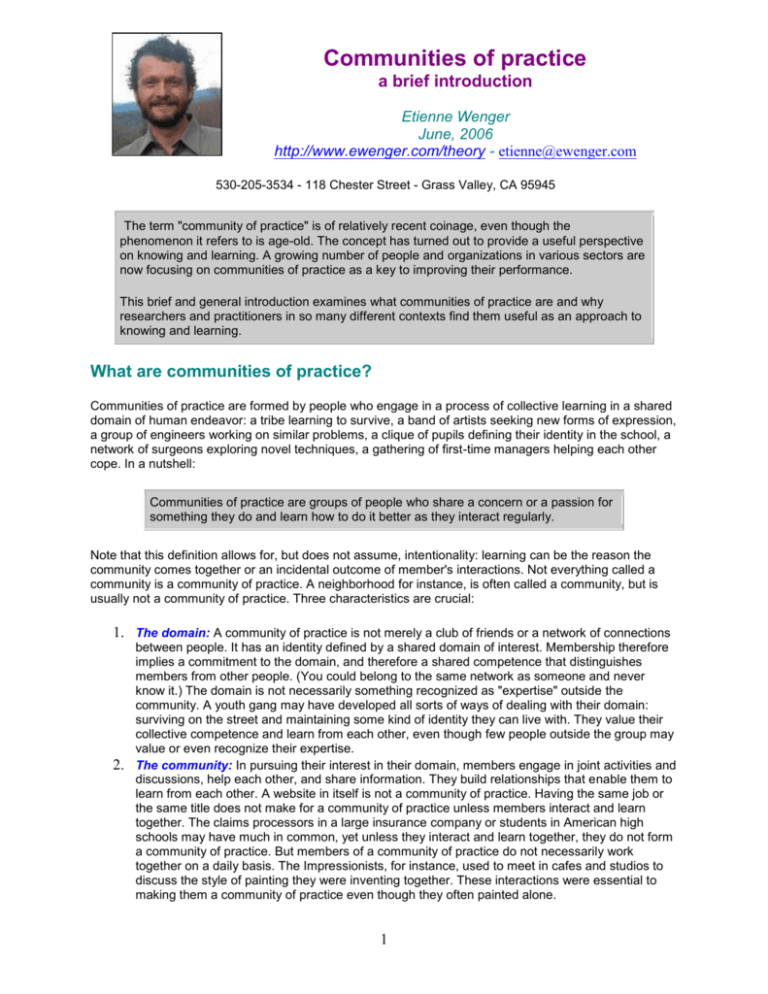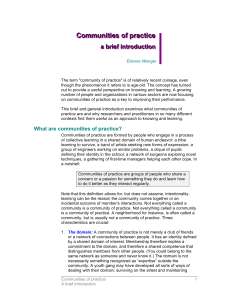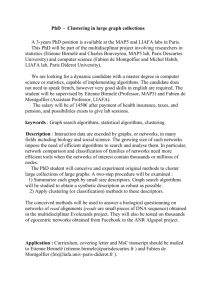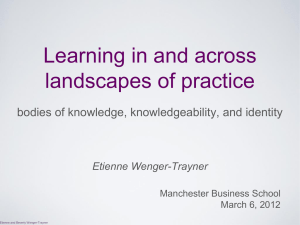Communities of practice
advertisement

Communities of practice a brief introduction Etienne Wenger June, 2006 http://www.ewenger.com/theory - etienne@ewenger.com 530-205-3534 - 118 Chester Street - Grass Valley, CA 95945 The term "community of practice" is of relatively recent coinage, even though the phenomenon it refers to is age-old. The concept has turned out to provide a useful perspective on knowing and learning. A growing number of people and organizations in various sectors are now focusing on communities of practice as a key to improving their performance. This brief and general introduction examines what communities of practice are and why researchers and practitioners in so many different contexts find them useful as an approach to knowing and learning. What are communities of practice? Communities of practice are formed by people who engage in a process of collective learning in a shared domain of human endeavor: a tribe learning to survive, a band of artists seeking new forms of expression, a group of engineers working on similar problems, a clique of pupils defining their identity in the school, a network of surgeons exploring novel techniques, a gathering of first-time managers helping each other cope. In a nutshell: Communities of practice are groups of people who share a concern or a passion for something they do and learn how to do it better as they interact regularly. Note that this definition allows for, but does not assume, intentionality: learning can be the reason the community comes together or an incidental outcome of member's interactions. Not everything called a community is a community of practice. A neighborhood for instance, is often called a community, but is usually not a community of practice. Three characteristics are crucial: 1. The domain: A community of practice is not merely a club of friends or a network of connections 2. between people. It has an identity defined by a shared domain of interest. Membership therefore implies a commitment to the domain, and therefore a shared competence that distinguishes members from other people. (You could belong to the same network as someone and never know it.) The domain is not necessarily something recognized as "expertise" outside the community. A youth gang may have developed all sorts of ways of dealing with their domain: surviving on the street and maintaining some kind of identity they can live with. They value their collective competence and learn from each other, even though few people outside the group may value or even recognize their expertise. The community: In pursuing their interest in their domain, members engage in joint activities and discussions, help each other, and share information. They build relationships that enable them to learn from each other. A website in itself is not a community of practice. Having the same job or the same title does not make for a community of practice unless members interact and learn together. The claims processors in a large insurance company or students in American high schools may have much in common, yet unless they interact and learn together, they do not form a community of practice. But members of a community of practice do not necessarily work together on a daily basis. The Impressionists, for instance, used to meet in cafes and studios to discuss the style of painting they were inventing together. These interactions were essential to making them a community of practice even though they often painted alone. 1 3. The practice: A community of practice is not merely a community of interest--people who like certain kinds of movies, for instance. Members of a community of practice are practitioners. They develop a shared repertoire of resources: experiences, stories, tools, ways of addressing recurring problems—in short a shared practice. This takes time and sustained interaction. A good conversation with a stranger on an airplane may give you all sorts of interesting insights, but it does not in itself make for a community of practice. The development of a shared practice may be more or less self-conscious. The "windshield wipers" engineers at an auto manufacturer make a concerted effort to collect and document the tricks and lessons they have learned into a knowledge base. By contrast, nurses who meet regularly for lunch in a hospital cafeteria may not realize that their lunch discussions are one of their main sources of knowledge about how to care for patients. Still, in the course of all these conversations, they have developed a set of stories and cases that have become a shared repertoire for their practice. It is the combination of these three elements that constitutes a community of practice. And it is by developing these three elements in parallel that one cultivates such a community. What do communities of practice look like? Communities develop their practice through a variety of activities. The following table provides a few typical examples: Problem solving "Can we work on this design and brainstorm some ideas; I’m stuck." Requests for information "Where can I find the code to connect to the server?" Seeking experience "Has anyone dealt with a customer in this situation?" Reusing assets "I have a proposal for a local area network I wrote for a client last year. I can send it to you and you can easily tweak it for this new client." Coordination and synergy "Can we combine our purchases of solvent to achieve bulk discounts?" Discussing developments "What do you think of the new CAD system? Does it really help?" Documentation projects "We have faced this problem five times now. Let us write it down once and for all." Visits "Can we come and see your after-school program? We need to establish one in our city." Mapping knowledge and identifying gaps "Who knows what, and what are we missing? What other groups should we connect with?" Communities of practice are not called that in all organizations. They are known under various names, such as learning networks, thematic groups, or tech clubs. While they all have the three elements of a domain, a community, and a practice, they come in a variety of forms. Some are quite small; some are very large, often with a core group and many peripheral members. Some are local and some cover the globe. Some meet mainly face-to-face, some mostly online. Some are within an organization and some include members from various organizations. Some are formally recognized, often supported with a budget; and some are completely informal and even invisible. 2 Communities of practice have been around for as long as human beings have learned together. At home, at work, at school, in our hobbies, we all belong to communities of practice, a number of them usually. In some we are core members. In many we are merely peripheral. And we travel through numerous communities over the course of our lives. In fact, communities of practice are everywhere. They are a familiar experience, so familiar perhaps that it often escapes our attention. Yet when it is given a name and brought into focus, it becomes a perspective that can help us understand our world better. In particular, it allows us to see past more obvious formal structures such as organizations, classrooms, or nations, and perceive the structures defined by engagement in practice and the informal learning that comes with it. Where does the concept come from? Social scientists have used versions of the concept of community of practice for a variety of analytical purposes, but the origin and primary use of the concept has been in learning theory. Anthropologist Jean Lave and I coined the term while studying apprenticeship as a learning model. People usually think of apprenticeship as a relationship between a student and a master, but studies of apprenticeship reveal a more complex set of social relationships through which learning takes place mostly with journeymen and more advanced apprentices. The term community of practice was coined to refer to the community that acts as a living curriculum for the apprentice. Once the concept was articulated, we started to see these communities everywhere, even when no formal apprenticeship system existed. And of course, learning in a community of practice is not limited to novices. The practice of a community is dynamic and involves learning on the part of everyone. Where is the concept being applied? The concept of community of practice has found a number of practical applications in business, organizational design, government, education, professional associations, development projects, and civic life. Organizations. The concept has been adopted most readily by people in business because of the recognition that knowledge is a critical asset that needs to be managed strategically. Initial efforts at managing knowledge had focused on information systems with disappointing results. Communities of practice provided a new approach, which focused on people and on the social structures that enable them to learn with and from each other. Today, there is hardly any organization of a reasonable size that does not have some form communities-of-practice initiative. A number of characteristics explain this rush of interest in communities of practice as a vehicle for developing strategic capabilities in organizations: Communities of practice enable practitioners to take collective responsibility for managing the knowledge they need, recognizing that, given the proper structure, they are in the best position to do this. Communities among practitioners create a direct link between learning and performance, because the same people participate in communities of practice and in teams and business units. Practitioners can address the tacit and dynamic aspects of knowledge creation and sharing, as well as the more explicit aspects. Communities are not limited by formal structures: they create connections among people across organizational and geographic boundaries. From this perspective, the knowledge of an organization lives in a constellation of communities of practice each taking care of a specific aspect of the competence that the organization needs. However, the very characteristics that make communities of practice a good fit for stewarding knowledge—autonomy, practitioner-orientation, informality, crossing boundaries—are also characteristics that make them a challenge for traditional hierarchical organizations. How this challenge is going to affect these organizations remains to be seen. Government. Like businesses, government organizations face knowledge challenges of increasing complexity and scale. They have adopted communities of practice for much the same reasons, though the formality of the bureaucracy can come in the way of open knowledge sharing. Beyond internal 3 communities, there are typical government problems such as education, health, and security that require coordination and knowledge sharing across levels of government. There also, communities of practice hold the promise of enabling connections among people across formal structures. And there also, there are substantial organizational issues to overcome. Education. Schools and districts are organizations in their own right, and they too face increasing knowledge challenges. The first applications of communities of practice have been in teacher training and in providing isolated administrators with access to colleagues. There is a wave of interest in these peerto-peer professional-development activities. But in the education sector, learning is not only a means to an end: it is the end product. The perspective of communities of practice is therefore also relevant at this level. In business, focusing on communities of practice adds a layer of complexity to the organization, but it does not fundamentally change what the business is about. In schools, changing the learning theory is a much deeper transformation. This will inevitably take longer. The perspective of communities of practice affects educational practices along three dimensions: Internally: How to organize educational experiences that ground school learning in practice through participation in communities around subject matters? Externally: How to connect the experience of students to actual practice through peripheral forms of participation in broader communities beyond the walls of the school? Over the lifetime of students: How to serve the lifelong learning needs of students by organizing communities of practice focused on topics of continuing interest to students beyond the initial schooling period? From this perspective, the school is not the privileged locus of learning. It is not a self-contained, closed world in which students acquire knowledge to be applied outside, but a part of a broader learning system. The class is not the primary learning event. It is life itself that is the main learning event. Schools, classrooms, and training sessions still have a role to play in this vision, but they have to be in the service of the learning that happens in the world. Associations. A growing number of associations, professional and otherwise, are seeking ways to focus on learning through reflection on practice. Their members are restless and their allegiance is fragile. They need to offer high-value learning activities. The peer-to-peer learning activities typical of communities of practice offer a complementary alternative to more traditional course offerings and publications. Social sector. In the civic domain, there is an emergent interest in building communities among practitioners. In the non-profit world, for instance, foundations are recognizing that philanthropy needs focus on learning systems in order to fully leverage funded projects. But practitioners are seeking peer-topeer connections and learning opportunities with or without the support of institutions. This includes regional economic development, with intra-regional communities on various domains, as well as interregional learning with communities gathering practitioners from various regions. International development. There is increasing recognition that the challenge of developing nations is as much a knowledge as a financial challenge. A number of people believe that a communities-of-practice approach can provide a new paradigm for development work. It emphasizes knowledge building among practitioners. Some development agencies now see their role as conveners of such communities, rather than as providers of knowledge. The web. New technologies such as the Internet have extended the reach of our interactions beyond the geographical limitations of traditional communities, but the increase in flow of information does not obviate the need for community. In fact, it expands the possibilities for community and calls for new kinds of communities based on shared practice. The concept of community of practice is influencing theory and practice in many domains. From humble beginnings in apprenticeship studies, the concept was grabbed by businesses interested in knowledge management and has progressively found its way into other sectors. It has now become the foundation of a perspective on knowing and learning that informs efforts to create learning systems in various sectors and at various levels of scale, from local communities, to single organizations, partnerships, cities, regions, and the entire world. 4 Further reading For the application of a community-based approach to knowledge in organizations: Cultivating communities of practice: a guide to managing knowledge. By Etienne Wenger, Richard McDermott, and William Snyder, Harvard Business School Press, 2002. Communities of practice: the organizational frontier. By Etienne Wenger and William Snyder. Harvard Business Review. January-February 2000, pp. 139-145. Knowledge management is a donut: shaping your knowledge strategy with communities of practice. By Etienne Wenger. Ivey Business Journal, January 2004. For technology issues: Supporting communities of practice: a survey of community-oriented technologies. By Etienne Wenger. Self-published report available at www.ewenger.com/tech, 2001. For in-depth coverage of the learning theory: Communities of practice: learning, meaning, and identity. By Etienne Wenger, Cambridge University Press, 1998. For a vision of where the learning theory is going: Learning for a small planet: a research agenda. By Etienne Wenger, available at www.ewenger.com/research, 2004. Etienne Wenger is as a leading expert on communities of practice. He was a pioneer of the "communities of practice" research and is now a globally recognized thought leader in the field. He was featured by Training Magazine in their "A new Breed of Visionaries" series. Etienne’s work is considered seminal to both research and practice in several domains, including business, education, and government. After working as a teacher for many years and getting a Ph.D. in artificial intelligence, Etienne Wenger joined the Institute for Research on Learning, where he developed his new learning theory centered on the concept of community of practice. For the last six years, he has been helping organizations develop and implement knowledge strategies based on communities of practice. He is much sought after as a keynote speaker and workshop leader. He also teaches courses on communities of practice online and is a co-founder and director of CPsquare, a practitioner’s community on communities of practice. Etienne’s work has been very influential. In the course of his career, he has provided a seminal conceptual framework for two different fields. His first book on artificial intelligence in education shaped the field known as "intelligent tutoring systems" in the 1980’s. Then in the 1990’s his work shaped the field of "situated learning" and "communities of practice." He was the co-author with Jean Lave of Situated Learning, where the term "community of practice" was coined. Building on these original ideas, he later wrote Communities of Practice: Learning, Meaning, and Identity, a seminal book that lays out the theory of communities of practice. His work did not remain theoretical, however. The book Cultivating Communities of Practice: a Guide to Managing Knowledge (co-authored with Richard McDermott and William Snyder) is addressed to practitioners in organizations and was published by Harvard Business School Press. A new book Digital Hanitats: stewarding technology for communities (co-authored with Nancy White and John Smith) focuses on the ever closer interplay between communities and technology. In education, this works has inspired a new line of research that focuses on the social nature of learning and its connection to communities, social practice, and identity. In business and government, this work has revolutionized the field of knowledge management. After an initial focus on technology this field is now placing the emphasis on the human aspects of knowledge. Indeed, cultivating communities of practice is increasingly recognized as the most effective way for organizations to address the knowledge challenges they face. It is commonplace to say that people are the most important resource in organizations. Yet we seldom understand this truism in terms of the communities in which individuals develop the capacity to create and share knowledge. Communities of practice—properly understood and 5 cultivated—are an organization’s most versatile and dynamic knowledge resource. Today, Etienne’s work is inspiring the knowledge strategy of most leading organizations in both private and public sectors. Etienne's new research project, "Learning for a small planet," is a broad, cross-sectoral investigation of the nature of learning and learning institutions at the dawn of the new millennium. Building on his foundational work on learning theory, this next installment focuses on "multi-scale" learning systems. The idea is that a learning theory for the 21st century cannot be confined by the traditional separation between education, business, and civic domains. Nor can it assume that learning is confined to specific settings or moments in people’s life. Learning has to be understood in the context of multi-scale social systems, which are dynamic constellations of communities of practice and through which learning shapes learners’ identities as life trajectories of multimembership. 6






